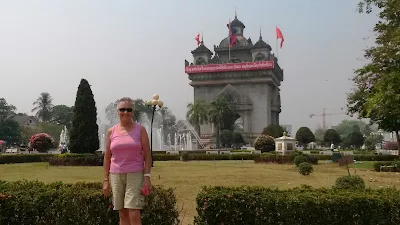 |
| Friendship Bridge-Thailand to Laos |
Laos is a mountainous, landlocked country.
After many years of conflict, it is now enjoying peace and a growing economy, and we were looking forward to our visit there.
After many years of conflict, it is now enjoying peace and a growing economy, and we were looking forward to our visit there.
After taking a taxi to the Chiang Mai airport,
we caught the 4:20 pm flight to Udon Thani about 670 km away in the
north-eastern corner of Thailand, near the border with Laos.
We landed about 1 hour later then grabbed a
taxi to the Friendship Bridge.
This Bridge spans the Mekong River and would take us over the border from Thailand into Laos.
This Bridge spans the Mekong River and would take us over the border from Thailand into Laos.
 |
| The village outside the Jungle House |
We had a driver who met us on the Laos side of
the Bridge, and after an interesting but long and dusty drive, we were
graciously welcomed at our accommodation, the Jungle House.
The Jungle House is owned by Michael
Boddington MBE, who, with his wife Xoukiet, have opened several rooms in their
home as boutique lodgings.
Their home, built and furnished in Lao style,
is in a village just outside Vientiane, the capital of Laos.
 |
| Victory Monument |
Dinner well finished, they were now relaxing
around the table with drinks, where of course, we joined them.
The next morning, Michael took us out in his
car for a tour of Vientiane.
 |
| Mekong in the distance |
There are no supermarkets here.
We also saw Pha That Luang, a stunning golden
Buddhist stupa in the centre of the city.
It is believed that this beautiful golden structure, was built over the top of an older structure dating back to the 3rd century.
It is considered
the most important Buddhist site in Laos.
It is believed that this beautiful golden structure, was built over the top of an older structure dating back to the 3rd century.
 |
| Street food stall and market |
We also visited the museum, which is housed in
a beautiful building, and enjoyed a cup of Vientiane’s famous coffee.
Then we visited the Victory Monument,
dedicated to people who fought in the struggle for Laos’ independence from
France.
One of our stops was on the edge of the mighty
Mekong River.
There was a long-running drought and with
river levels so low, it was hard to see the water’s edge from the road.
Vientiane was a French colony at one stage,
and the French influence such as street signs, cafes etc, rub up against local
food stalls, typical Laotian homes, and Buddhist wats.
It's a fascinating place.
The next day, Michael took us to COPE – the
Cooperative Orthotic and Prosthetic Enterprise.
He started COPE in 1997, as a not-for-profit
organisation.
Its aim is to provide treatment and
rehabilitation programmes for Laotian people with physical disabilities.
Most of the disabled people are victims of
hidden and unexploded armaments (mainly mines and missiles), dropped or left by
the US Army between 1964 and 1973 during the Vietnam War.
When we were there, we were told that one
person is killed or injured every day by these unexploded armaments.
COPE funds the manufacturing of items such as
wheelchairs, and prosthetic legs, arms and hands for victims of the explosions.
It was a sobering reminder of how this whole
south-eastern part of Asia had been affected by the Vietnam War.
After a few days at the Jungle House enjoying
the company of Michael and Xoukiet, their Laotian home cooked meals, ample wine
cellar, and beautiful home, it was time to move on.
Our next stop is north of Vientiane, in Luang
Prabang.
It will be interesting to see if there is any difference in life style between Vientiane and this northern city.
It will be interesting to see if there is any difference in life style between Vientiane and this northern city.


